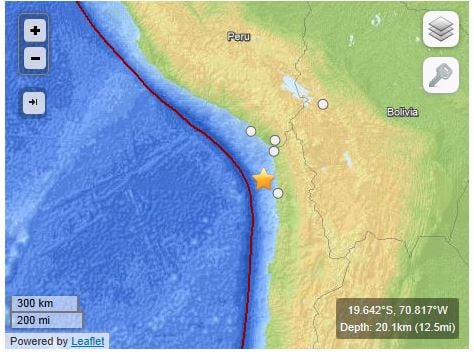Chile Earthquake
Status: Closed
| Type of posting | Posting date(EST): | Summary | Downloads |
|---|---|---|---|
| First Posting | 4/2/2014 10:00:00 AM |
|
First Posting | Summary
Posting Date: April 2, 2014, 10:00:00 AM
According to the United States Geological Survey (USGS), a magnitude 8.2 earthquake struck off the coast of Chile at 7:46 p.m. Eastern time (8:46 p.m. local time). The quake struck at a depth of 20.1 kilometers, and the epicenter was located 95 km northwest of Iquique, Chile. The Pacific Tsunami Warning Center issued tsunami warnings for Chile and Peru, which have since been lifted. The USGS issued a yellow alert for fatalities, meaning some casualties are possible (six deaths have been reported so far), and an orange alert for economic losses, meaning that significant damage is likely in the epicentral region.
The most imminent threats from the quake were tsunami waves. The Chilean government issued mandatory evacuation orders for those living along the coast. These orders remained in effect until early this morning for coastal areas north of Antofogasta, Chile. As a result, nearly 900,000 residents spent the night in inland locations. Chile’s navy reported that the first tsunami wave hit the coast within 45 minutes of the quake. Waves as tall as 6.9 feet came ashore in the northern port cities of Pisagua and Iquique, causing flooding but no major reports of damage.
The president of Chile, Michelle Bachelet, declared a state of emergency and ordered special force teams to guard the city against looting. These teams were also tasked with rounding up the nearly 300 prisoners who escaped from a women’s prison in Iquique. Thus far, there have been no major reports of damage, with the exception of destroyed adobe homes in Arica. Landslides have blocked roads throughout the region, and power and telecommunications outages are widespread. There are also fires burning in some locales. The quake also shook modern buildings in nearby Peru and in Bolivia’s high altitude capital of La Paz. None of the major copper mining companies have so far reported problems with their operations (Chile is the world’s largest copper producer).
Because the quake’s epicenter was located quite a distance from the coast, the shaking inland was not very severe and should serve to reduce the insured losses from this event. Also mitigating the potential for insured losses is that the impacted area is very rural and characterized primarily by low-rise buildings constructed from either unreinforced masonry or confined masonry. Since unreinforced masonry is vulnerable to earthquake damage, these buildings will likely experience moderate damage such as falling roofs and noticeable cracks in walls. Damage to confined masonry buildings will be limited, as this construction type has been used in Chile for many years and has performed well in past earthquakes.

Epicentral location (Source: USGS)
Regional Seismicity
The April 1, 2014, temblor occurred in a region known as the Chile or Iquique seismic gap. The last major earthquakes to hit this region were two M8.8 earthquakes—one that occurred just north of the Iquique gap in 1868 and one that occurred in the Iquique gap in 1877. There have, however, been recent increases in seismicity rates in the vicinity of yesterday’s quake, including an M6.7 earthquake with similar faulting mechanisms on March 16, 2014, and a seismic sequence of three M6.2 events on March 17, 22, and 23, respectively. The location of yesterday’s quake places it along the northern end of this sequence.
At the latitude of the April 1st earthquake, the Nazca plate subducts eastward beneath the South America plate at a rate of 65 mm/yr. Subduction along the Peru-Chile Trench to the west of Chile has led to uplift of the Andes mountain range and has produced some of the largest earthquakes in the world, including the 2010 M8.8 Maule earthquake in central Chile, and the largest earthquake on record, the 1960 M9.5 earthquake in southern Chile. The April 1, 2014, M8.2 earthquake in northern Chile occurred as the result of thrust faulting at shallow depths near the Chilean coast. The location and mechanism of the earthquake are consistent with slip on the primary plate boundary interface, or megathrust, between the Nazca and South America plates.
The AIR earthquake team is continuing to monitor the situation and will provide updates if warranted. Because the region is relatively sparsely populated, however, AIR does not expect significant insured losses.